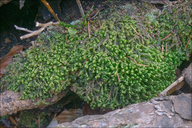|
|
click photo for larger file

Bazzania trilobata
Greater Whipwort
|
Photographer: Dr. Amadej Trnkoczy
ID: 0000 0000 1021 1377 (2021-10-31)Copyright © 2021 Dr. Amadej Trnkoczy
|
|
INFORMATION PROVIDED WITH THE PHOTO
|
date of photo Oct 26, 2021
latitude 46.39886 longitude 13.70239
View on Google Maps.
location
Upper Trenta valley, Zapodn place, right bank of (mostly dry) Soča river bed, East Julian Alps (Posočje, Slovenia)family
Lepidoziaceae
notes Slo.: trokrpi bičnik - syn.: Mastigobryum trilobatum (L.) Nees, Pleuroschisma trilobatum (L.) Dumort., Jungermannia trilobata L. - Habitat; mixed forest, Fagus sylvatica and Picea abies dominant trees; almost flat terrain, calcareous, old colluvial deposits; locally probably acid ground (understory vegetation mainly Vaccinium myrtillus L.), in shade, partly protected from direct rain by tree canopies, average precipitations ~ 3.000 mm/year, average temperature 4-5 deg C, elevations 1.000 m (3.280 feet), alpine phytogeographical region. Substratum: humus layer on roots of a Picea abies stump in its initial stage of disintegration and on soil among the roots. Comments (pertains to pictures in the Flicker album Bazzania trilobata): Bazzania trilobata is a relatively common and among the largest and most noticeable leafy liverworts. Its quite large mats can be found on boggy soils, forest ground, rotten logs, and at the bases of trees. It is a widespread species. Most of others in this genus are more typical of tropical environments. Bazzania trilobata can be recognized by a special arrangement of its leaves. As seen in my close-up photos, the upper edges of the leaves overlap the lower edges of the leaves above them. This is so called incubous leaf arrangement. Most of other leafy liverworts have the opposite arrangement, succubous, where the lower edges of the leaves overlap the upper edges of the leaves below them. Liverworts superficially look similar to mosses. However, apart to other less conspicuous differences, they have differently arranged leaves on the stem. Liverwort leaves are usually arranged in two lateral ranks with a third row of usually much smaller and differently shaped leaves on the back side of the stem (see picture 7a.). Moss leaves have usually a spiral arrangement. If not so, they always lack the third row of the leaves. Ref.: (1) Ian Atherton, Ed., Mosses and Liverworts of Britain and Ireland - a field guide, British Bryological Society (2010), p82. (2) V. Wirth, R. Duell, Farbatlas Flechten und Moose, Ulmer, (2000), p 204. (3) B. Marbach, C. Kainz, Moose, Farne und Flechten, BLV (2002). p 46. (4) W. Rothmaler, Exkursionsflora von Deutschland, Niedere Pflanzen, Band 1, 3.Aufl., Spectrum Akademischer Verlag (2005), p 660.camera Canon G11, 6.1-30mm/f2.8-4.5
contributor's ID # Bot_1415/2021_DSC4855 photo category: Plant - mosses/etc
|
MORE INFORMATION ABOUT THIS PLANT
|
| common names
Greater Whipwort, Threelobed Bazzania (photographer)
View all photos in CalPhotos of Bazzania trilobata Check Google Images for Bazzania trilobata |
|
The photographer's identification Bazzania trilobata has not been reviewed. Click here to review or comment on the identification. |
|
Using this photo The thumbnail photo (128x192 pixels) on this page may be freely used for personal or academic purposes without prior permission under the Fair Use provisions of US copyright law as long as the photo is clearly credited with © 2021 Dr. Amadej Trnkoczy.
For other uses, or if you have questions, contact Dr. Amadej Trnkoczy amadej.trnkoczy[AT]siol.net. (Replace the [AT] with the @ symbol before sending an email.) |
|
|
